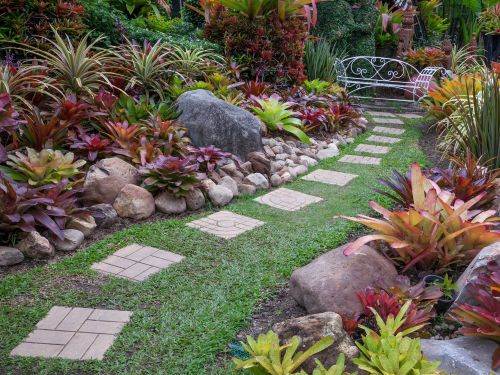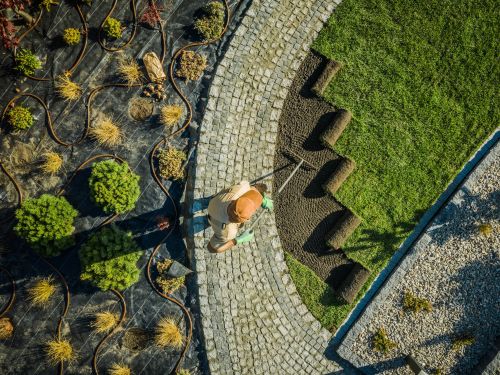Desert landscapes may appear uniform at first glance—hot, dry, and sun-drenched—but every yard contains its own unique microclimates. These small environmental zones, shaped by variations in sunlight, shade, wind, and soil, can dramatically affect how plants grow. By understanding and utilizing these differences, homeowners can create a thriving, water-efficient yard that brings color and life to even the harshest desert setting.

Call Desert Environments Today
Let’s Build Your Desert Oasis
Understanding Microclimates in Desert Landscapes
A microclimate is a small area within your yard that has slightly different conditions from its surroundings. In the desert, where temperatures can swing 30 degrees or more in a single day, these variations can mean the difference between a flourishing garden and one that struggles to survive.
Factors that influence microclimates include:
- Sun Exposure: South- and west-facing areas receive intense afternoon heat, while north-facing spots may stay cooler and shadier.
- Shade and Structures: Trees, walls, fences, and buildings cast shadows that protect plants from excessive sun and reduce water loss.
- Wind Patterns: Wind dries out soil and foliage faster, but sheltered corners retain moisture and stay slightly cooler.
- Elevation and Slope: Low areas collect more water after rain or irrigation, while elevated zones drain quickly and dry out faster.
By mapping these variations, you can make smarter planting decisions that match each plant’s specific needs.
Mapping Your Yard’s Microclimates
Before planting, spend a few days observing your yard at different times—morning, midday, and late afternoon. Note which areas get full sun, partial sun, or consistent shade. Watch how the wind moves across your property and where water tends to pool after rainfall or irrigation.
You can also use temperature sensors or even smartphone apps to record soil temperature and humidity levels. These insights will help you group plants by their preferred growing conditions, maximizing survival rates and minimizing water waste.
Planting Tips for Different Microclimates
Hot, Sunny Areas
These are typically south- or west-facing zones that receive the most direct sunlight. Choose heat-tolerant and drought-resistant plants that thrive under full sun.
Best Plant Choices
- Red yucca (Hesperaloe parviflora)
- Desert marigold (Baileya multiradiata)
- Lantana
- Mexican bird of paradise (Caesalpinia mexicana)
Planting Tips
- Use gravel mulch to reflect heat evenly and prevent soil compaction.
- Install drip irrigation to deliver water directly to roots, reducing evaporation.
- Space plants well apart to encourage airflow and prevent overheating.
Shaded or Partially Shaded Areas
Found near walls, trees, or buildings, these spots are cooler and hold moisture longer. Choose plants that prefer filtered sunlight or afternoon shade.
Best Plant Choices
- Texas mountain laurel (Sophora secundiflora)
- Aloe vera
- Agave attenuata
- Damianita daisy (Chrysactinia mexicana)
Planting Tips
- Use organic mulch like bark chips to help retain moisture and improve soil structure.
- Avoid overwatering—shade slows evaporation, which can lead to root rot.
- Position plants to take advantage of morning sun for balanced growth.
Windy or Exposed Spots
Wind can quickly dry out both soil and foliage, stressing plants and increasing water demand. These areas benefit from windbreaks and hardy desert shrubs.
Best Plant Choices
- Creosote bush (Larrea tridentata)
- Desert willow (Chilopsis linearis)
- Brittlebush (Encelia farinosa)
- Globe mallow (Sphaeralcea ambigua)
Planting Tips
- Add rock borders or boulders to deflect wind and trap moisture.
- Group plants close together to create a natural barrier.
- Use ground covers to protect soil from erosion and temperature fluctuations.
Low-lying or Moist Areas
Even in the desert, some areas stay slightly wetter—such as depressions where water collects. These are ideal for plants that prefer a bit more hydration.
Best Plant Choices
- Desert ruellia (Ruellia peninsularis)
- Arizona yellow bells (Tecoma stans)
- Deer grass (Muhlenbergia rigens)
Planting Tips
- Ensure proper drainage—avoid creating soggy soil conditions.
- Mix sand or gravel into the soil for aeration.
- Use these areas strategically to capture rainwater and reduce runoff.
Designing with Microclimates in Mind
A successful desert landscape design blends beauty, function, and sustainability. Arrange plants by their microclimate compatibility—hot and sunny plants in open areas, shade-loving ones under canopies or north walls, and hardy shrubs as wind barriers.
Incorporating native and adaptive species ensures long-term success while minimizing maintenance and water use. Native plants are already acclimated to desert extremes, making them resilient choices for any homeowner looking to build a thriving ecosystem.

